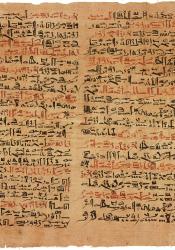Ancient Egyptian Anatomical Studies
Leonardo made several extremely important discoveries that directly contradicted prevailing scientific beliefs of the time, such as the concept that the heart defined the circulatory system, and not the liver. However, such discoveries had been made many centuries previously by the Ancient Egyptians, whose forays into embalming the human body allowed them to recognize the presence and location of several major organs, including the heart, the liver, the spleen, the kidneys, the uterus, the bladder, and even the hypothalamus as early as 1600 BC.
The Ebers Papyrus, published c. 1550 BC, contained a much more detailed treatise on the anatomy and location of the heart that also placed it at the center of the circulatory system. However, the Ancient Egyptians failed to realize the separation of the circulation of blood from the circulation of other fluids, and also credited vessels connecting to the heart with carrying substances like urine, semen, and tears.
Sources:
"History of Anatomy." https://en.wikipedia.org/wiki/History_of_anatomy. Accessed 8 Mar. 2018.
Image from: https://commons.wikimedia.org/wiki/File:EdSmPaPlateVIandVIIPrintsx.jpg

